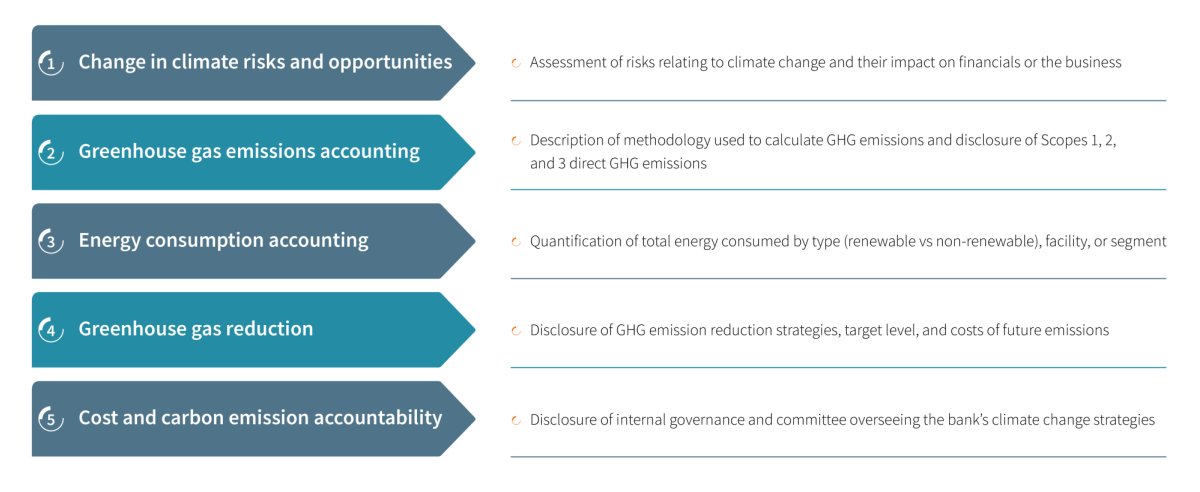In this article, we look at the four areas, such as climate risk data, credit risk models, risk-mitigating factors, and disclosures on climate credit risk, that banks should examine to enhance climate risk integration in credit risk frameworks.
To enhance climate risk integration in credit risk frameworks, banks should ensure that four aspects are closely examined. These include the relevance of credit risk model inputs (data), the robustness of scenario analysis and stress testing methodology (models), the proper identification of credit risk-mitigating opportunities (risk-mitigating factors), as well as the transparency and accuracy of counterparties’ climate risks representation (disclosures).
Enhancing climate risk integration in credit risk frameworks

Below is a more detailed explanation of the approach:
1. Enhancing credit risk model inputs to better predict climate risk impact
Historical data are often a poor indicator of future climate change developments. As climate change evolves progressively, banks may not have the necessary verifiable data to simulate adverse scenarios in stress testing exercises, where extreme physical climate changes or regulatory transition activities result in massive economic downturns.
With the acceleration in global warming, governmental bodies around the world have increased their commitment to combat climate change and limit the rise in global temperature to an unprecedented level. There may not be adequate historical data to model the business risks faced by banks’ clients, arising from the policy and regulatory, technology, and legislative shifts in a bid to transition to a low-carbon economy. Moreover, banks often use readily available stale metrics that contain little predictive value.
To overcome the low data quality issue, banks can integrate their core banking systems with specialised external climate risk data platforms, such as Bloomberg, ICE Data Services, Dow Jones, and Moody’s ESG Analytics, to name a few, in order to obtain timely insights. For instance, banks can leverage Bloomberg’s corporate governance and operations data to identify companies that are addressing climate change risks, allowing banks to ascertain that the transition risk of these counterparties is low, which leads to an increase in credit rating scores for these counterparties.
Banks may also uncover concentrated carbon risks in their credit portfolio through Bloomberg’s Portfolio Carbon Footprint Tool, which shows the carbon footprint calculations across industries and sectors
Apart from Bloomberg, another interesting data provider would be Moody’s Analytics, which provides forward-looking physical data on 10,000 companies with millions of corporate facilities and real estate assets globally. The platform quantifies climate risks through simulating various macroeconomic scenarios across an 80-year horizon, defines the probabilities of default using its Expected Default Frequency (EDF) model, and translates climate trajectories into credit risk variables for better capital adequacy assessment.
Obtaining climate risk data is not rocket science given the wide range of robust offerings by various data services providers. Hence, it is crucial for banks to stay attentive to their credit risk assessment objectives and ensure that climate risks are properly factored in to minimise their residual credit risks.
2. Accounting for climate risk factors in credit risk models
Existing credit models are designed to quantify the banks’ expected credit losses within the next one to three years using static financial data. These credit risk projections modelled using short-term horizons neglect the drawn-out effects of transition risks, while the use of backward-looking historical loss data undermines the material uncertainty surrounding the timing and magnitude of physical risks. Moreover, the varying degrees of physical and transition risk exposure across industries and geographies suggest a non-linear manifestation of climate risks in credit risk.
To understand the translation of climate risks into credit risks at a more granular level, banks may consider segregating physical from transition risk models, with a further breakdown into counterparty and thematic levels.
On the counterparty level physical risk assessment front, banks may leverage MSCI GICS classification to identify carbon-related and climate-sensitive corporate clients. In terms of transition risk, banks may leverage MSCI’s Low Carbon Transition (LCT) score to assess the sensitivity of transitioning to a low carbon economy at the counterparty level for credit risk. On a thematic level, on the other hand, different models can be built to monitor credit risk exposure against climate goals and key interim milestones, such as Paris Alignment and Net Zero Carbon Emissions.
In a nutshell, it is imperative for banks to model the volatility, growing magnitude, and trajectory of chronic physical risks over a longer time horizon instead of relying on past climate patterns. The prescribed modelling approach should also take guidance from a framework that evaluates the transition paths to net carbon zero under different climate scenarios.
3. Broadening scope of risk mitigation and adaptation strategies
Common credit risk mitigating strategies include imposing a haircut on pledged collateral, entering into credit default swaps, and closely monitoring margin shortfalls through daily reporting. In today’s world, as market movements become increasingly volatile and public sentiment towards climate change grows increasingly aggressive, the effectiveness of traditional credit risk mitigating methods has somewhat scaled back.
Banks should start considering how climate transition risks can be better managed. For instance, climate-related credit risks can be mitigated by steering banking clients towards transformational environmentally sustainable business models that drive energy-efficient operations, products, and services. Sector-specific policies in managing and providing sustainable financing offerings, such as prohibiting banking transactions with certain segments of environmentally sensitive industries and issuing green bonds or providing structured financing solutions to renewable energy businesses, can be applied.
To further nip potential climate-related credit risk exposure in the bud, the top management needs to set the right tone from the top and guide the first line of defence to encourage investor clients to invest sustainably through thematic investment fund offerings and targeted climate change investment funds. By having more sign-ups for green financing and investments, banks would naturally have their physical and transition risks reduced.
4. Overcoming discrepancies in counterparties’ climate risk disclosures
Currently, the lack of a set of standardised environmental disclosure rules introduces ambiguity to the interpretation of climate risk modelling results. While it is common and logical for banks to use proxy data where disclosure documentation of counterparties is not available, banks are unknowingly relying on heterogenous estimates derived from diverse underlying modelling practices that could cloud the clarity of datapoints collected and add a layer of complexity to risk measurement.
In order to ensure greater transparency on the bank’s climate-related risk exposure, banks are highly recommended to assess their counterparties’ climate risks according to the disclosure standards set out in the Task Force on Climate-Related Financial Disclosure (TCFD) guidelines. This task force is one of the most widely adopted frameworks globally that defines the standardised disclosures necessary to facilitate the financial markets to measure, price, and manage climate risks.1
Policymakers all over the world have endorsed the TCFD framework, as it streamlines the way the impact of climate risks on credit risk exposure should be interpreted. TCFD champions the belief that better disclosure brings about a more effective evaluation of climate risk across the value chain, thereby allowing banks to make more informed capital allocation decisions and forecast risk exposures from their counterparties over different time horizons.
Obtaining a holistic assessment
When performing credit risk assessment on its counterparties and assessing their overall susceptibility to climate risks, banks should look out for the five types of key disclosures in counterparties’ annual reports, namely change in climate risks and opportunities, GHG emission amounts, energy consumption levels, GHG reduction target levels, and how the costs from GHG emissions are quantified.2

Our previous article listed the different types of climate risks and how they integrate with traditional financial risk taxonomies.
Check our previous article to learn more
How Synpulse can help
As climate risks pervade banks’ credit and investment portfolios, as well as day-to-day operations, it is crucial for banks to start incorporating climate risk factors in their risk management systems and processes. At Synpulse, we have both the subject matter expertise and end-to-end project delivery capabilities to develop bespoke solutions that best address individual clients’ needs.
For further information or a non-binding initial consultation, contact us.

